PROVINCETOWN — In 1959, a Provincetown teenager named George Van Dereck Haunstrup, more commonly known in town as Moe Van Dereck, breathed life into a storied sailboat on its last legs. Tarkoo was one of nine Inuit-inspired vessels built in Provincetown between 1928 and 1933. In those years, the “Eskimo boats,” as they were called at the time, were raced competitively in Provincetown and Wellfleet and were the fastest boats on the Outer Cape. (The term “Eskimo” is now considered offensive by some of the Inuit and Yupic people of the Arctic regions.)
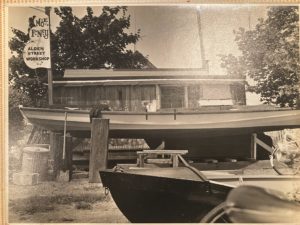
The craftsman keel of the Tarkoo was swapped for an outboard motor when the races stopped during World War II. By the time Van Dereck began his restoration, most of the nine original boats had been decommissioned. He salvaged the keel from the Ipah, another of the original boats, whose wreckage was resting in the sand near the home of its original owner, Margaret Seaver, in Provincetown.
Van Dereck raced the restored boat in the harbor until 1967, when he sold it. After that, according to Bob Gebelein, Seaver’s nephew, Tarkoo was wrecked.
The nine Inuit-inspired boats were the product of Jonathan “Jot” Small’s voyages to the Arctic with Adm. Donald Baxter MacMillan, the Provincetown-born explorer. According to historical accounts, Small thought the flat bottom and shallow keel of the Inuit boats he saw in the far north would be, as Gebelein put it, “ideal for the waves of Cape Cod Bay.” When Small returned to Provincetown, he built the nine boats and gave them each a name in the Inuit language. He named his own boat Imarhar, meaning “Perhaps.”
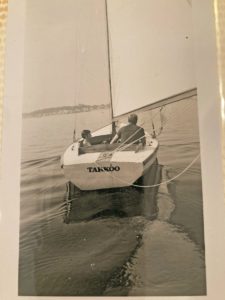
The other boats and their owners: Akpah (“A bird”), Alfred Mayo; Karnow (“I don’t know”), Dr. Percival Eaton; Tarkoo (“Look here”), Myrick Young; Arguy (“Come on”), Stanley Snow; Belapadoo (“Small baby of the fleet”), Coulton Waugh; Ipah (“My buddy”), Margaret Seaver; Mickyook (“Little man”), Hersey Taylor; and Suo (“Yes, that is so”), Joseph Hawthorne.
Small was a Renaissance man — besides building boats, he was a mechanic and a member of the U.S. Lifesaving Service, and he owned a restaurant. He also raced the Imarhar in contests sponsored by the Provincetown Yacht Club; in 1931, he won its first documented race. Throughout that decade, Small’s boats were the fastest and most popular in town, competing literally in a class of their own.
The most dominant skipper was Alfred Atkins Mayo in the Akpah. In Time and the Town, Mary Heaton Vorse wrote that Mayo was “one of the greatest fisherman who ever sailed from Provincetown.” His “nose for fish,” she declared, was without equal.
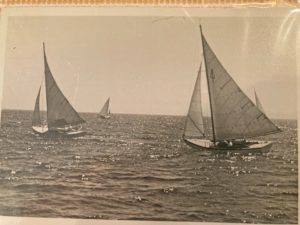
The same might be said of his nose for the finish line. The admittedly uneven and partial record of race results published in the Provincetown Advocate between July 1931 and August 1940 shows, out of 18 races, Mayo came in first 10 times, second four times, third once, and fourth three times. Four owners of Jot Small’s other Inuit-inspired boats combined to win the other eight races.
Jot Small’s boats disappeared from Provincetown waters as quickly as they had appeared. Intra- and inter-town racing rivalries spurred boatbuilders to challenge the nine vessels. Hollis Nickerson of Wellfleet beat Alfred Mayo in a 1936 race between the Provincetown and Chequessett yacht clubs. Another Provincetown-built boat, Ranger, came in second in a race against several of Small’s boats in 1940.
When the U.S. entered World War II in 1941, racing stopped entirely. With many boatyard people off to war, the boats were neither raced nor well maintained. A classified ad in the Advocate on Aug. 2, 1945, just below an ad for a “used baby carriage,” captures the disintegration of the group: “23-foot Eskimo class Sailboat. Write Box 93 Provincetown.”
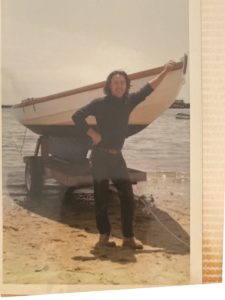
In a 1946 postwar race, the Ipah was the only one of Small’s boats to compete. Some of the remaining boats fell victim to extreme weather or otherwise vanished; in 1954, Hurricane Carol destroyed Arguy IV and Ipah.
The boats that survived into the 1950s did so using parts of their wrecked siblings. In 1950, Joe Andrews, who owned Ranger, bought Akpah from Alfred Mayo. Renaming it Vicky, he raced the boat until 1954, when it was sunk by Carol. Vicky was salvaged, however, and Andrews sold it to Margaret Seaver, who had it repaired at Flyer’s Boatyard in Provincetown. The repair combined pieces from three boats: the hull from Akpah, the sails from the original Ipah, and the mast from the Arguy. Seaver renamed it the Ipah II 1-7-4, the three numbers in commemoration of the three original boats. That boat, the last of Jot Small’s fleet, survived into the late 1950s.
Eventually, the Ipah II mouldered in North Truro. It was dismantled in the 1990s. A handful of sailors still remember the boats from firsthand experience. Bob Gebelein, who worked on the Ipah’s crew in 1946 for his aunt Margaret, remembers those days fondly, even if the job was a difficult one.
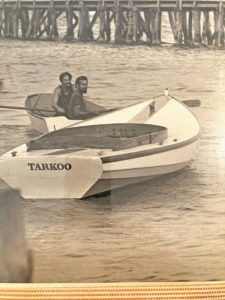
“The job of the crew,” he says, “was to lie forward on the deck as far as possible. It was very wet up there.”
Moe Van Dereck, who saved the Tarkoo from an early demise, regards the experience with reverence. In an interview conducted on a bench in front of the Symie Maryles Gallery on East Commercial Street, Van Dereck, who is now a trim 81 with the clear voice of a man half his age, explained the particular technique required to craft the hull. The planks needed to overlap with a nail driven through them; the nail was then curled on the inside to secure the bond. The technique, called lapstrake, gave the hull its striking appearance.
“I just loved that boat,” says Van Dereck, wistfully, with its “wee bit of dory in it.”
